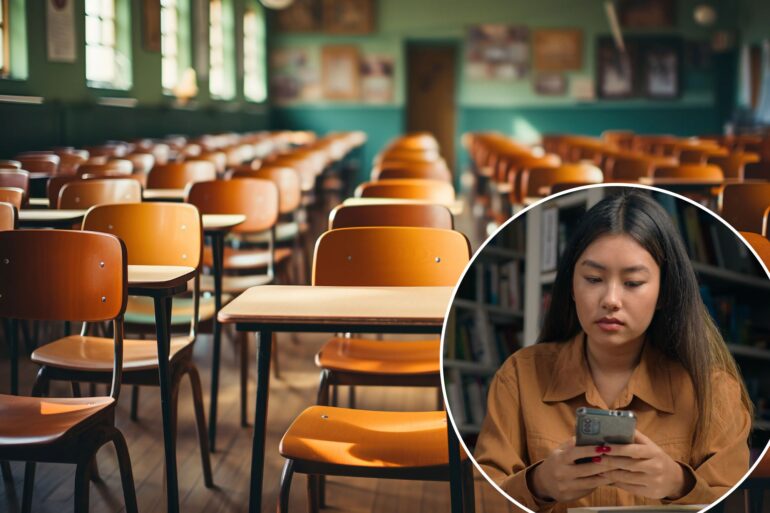🔴 Website 👉 https://u-s-news.com/
Telegram 👉 https://t.me/usnewscom_channel
Higher education is taking a hit.
According to new data from the National Student Clearinghouse Research Center, first-year enrollment dropped by more than 5% this year, with enrollment by recent high school graduates dropping by more than 6%.
While overall enrollment still grew, this was largely inflated by a sizable pandemic dip — many fewer students enrolled in 2020, and that class just graduated.
Experts have been quick to blame the decline in freshmen on the dysfunctional rollout of the Free Application for Federal Student Aid (FAFSA) last year.
“This really reconfirms the strong connection between FAFSA completion and enrollment,” said Bill De Baun, senior director of the National College Attainment Network.
As risible as the FAFSA delays were — with the Department of Education bureaucrats keeping millions of families waiting months for an application that would help them determine if and where their kids might be able to go to college — the recent enrollment results also suggest deeper problems.
According to a poll released by Gallup and the Lumina Foundation over the summer, only 36% of adults say they have a “great deal” or “quite a lot” of confidence in higher education. That’s a decline of 57% in less than a decade.
A closer look at the enrollment figures suggests that not all groups are losing confidence at the same rate.
For one thing, the decline in first-year enrollment by men was steeper than the decline for women.
Not by a lot — 6.4 compared to 6.0 — but, given that women already outnumber men in college by a 3 to 2 ratio, it means that the male revolt against higher education is accelerating.
Moreover, there’s no reason why the FAFSA bungle would affect men more than women. But there is an obvious explanation: The messages coming from colleges and universities about “toxic masculinity,” and left-wing politics in general, have turned off young men — who tend to lean more to the right — more than women.
Secondly, the decline in first-year enrollments also varies by race. While some doomsayers predicted that the Supreme Court’s recent affirmative action decision would have a devastating impact on the access to higher education by racial minorities, the truth is that white students appear to be deciding against college.
First-year white enrollment declined by 11.6% from last year, compared to a decline of just 6.1% among blacks. Hispanic and Asian enrollment declined by about 1% each.
Once again, problems with FAFSA cannot explain these differential declines.
The diversity, equity, and inclusion regime instituted over the past decade has not welcomed white males, with predictable results. The protests against US policies in the Middle East since the Hamas attacks of October 7, 2023, have only exacerbated those problems.
It is difficult for many to take higher education seriously when they see protestors taking over academic buildings, chanting slogans about genocide, and demanding that colleges and universities should be “decolonized.”
They are also aware that, despite rhetoric about academic freedom and the free exchange of ideas, the climate of opinion on the campus is overtly hostile toward conservative students, especially so to those who might support President-Elect Donald Trump.
So where are these first-year students going instead?
The decline seems to have been significantly smaller for associate degree programs than for bachelor’s degrees. And shorter-term credential programs are also popular.
Another way to read this: Students coming out of high school are not sure about the utility of college when it comes to getting a job. And once they are off the college track, it’s not clear when or whether they will get back on.
Schools certainly realize there is an issue. There is a significant dip in the college-going population expected in the next couple of years. And with demand softening, universities have started to lower their prices.
As an article in the Chronicle of Higher Education noted recently: “While sticker prices have continued to balloon to as large as $100,000 at some private, nonprofit universities, the average net price — the remaining cost of tuition after institutional and grant aid is deducted — for undergraduate students entering their freshman year at these institutions clocked in at $16,510 for the 2024-25 academic year, down from $19,330 in 2006-07 (adjusted for inflation to 2024 dollars).”
A similar trend occurred at public institutions.
Lowering the cost of higher education will certainly encourage some students to attend who otherwise wouldn’t. But, as the recent enrollment declines show, the issues are not all financial.
Higher education leaders have turned off entire demographic groups of younger Americans with identity politics — and politics more generally.
If they want to get them back, then they will have to make changes that go far beyond offering more financial aid.
James Piereson is a senior fellow at the Manhattan Institute. Naomi Schaefer Riley is a senior fellow at the American Enterprise Institute.

